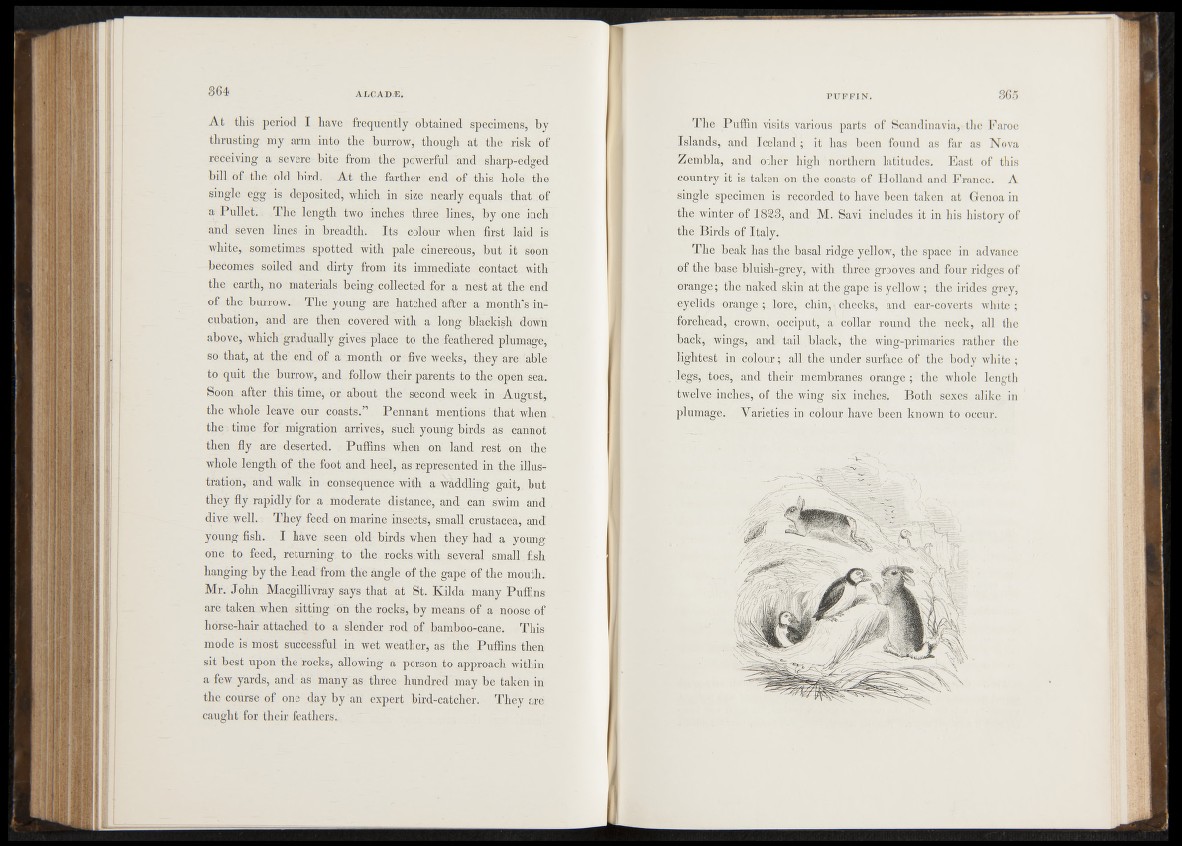
At this period I have frequently obtained specimens, by
thrusting my arm into the burrow, though at the risk of
receiving a severe bite from the powerful and sharp-edged
hill of the 'old bird. At the farther : end of this hole the
single egg is deposited, which in size nearly equals that .of
a Pullet.. The length two inches thrée lines, by one inch
and seven lines-in breadth; , Its co'lqur when first laid is
white, sometimes spotted with pale cinereous, b u t. it: shon
—becomes soiled and dirty from its immediate contact .with
the earth, no materials being collected for a nest at the end
of the burrow. The young are hatched after a mohtb’s^dn?
çubation, and are then ; covered with a long blackish down
above, which gradually gives place. to the-jeathered plumage;
so that, at the' end of a" month or five weeks, they are able
to quit thé "burrow, and..follow their; parents to the open sea;
Soon after this time, or about the second week in ; August,
the whole leave our coasts.” Pennant mentions that when
the ; time foj'migration arrivesj such yourig birds , âs cannot
then fly are . deserted. ; Puffins when on land rest bn the
whole length of the foot and heel, as represented' in the illuST
tration, and walk in consequence with a Addling gait,, but
th'eÿ flÿ rapidlÿ for a moderate distance, and ean swim. and ,
dive'.well«'; They feed on marine insects, small Crustacea, arid
young fish. I hâve .seen old birds when they had a yo.ung
one to feéd, returning, to; the rocks,with several small ..fish
hanging.by the head'from the angle of the gapé of the mouth.
Mr. John Macgillivray says that at St. Kilda many Puffins
are taken .when sitting 'on the rocks, by means, o f. a noose - of
horseffiair attached to a slender rod of bamboo-cane. This
mode, is most successful in wet. weather, as the Puffins then
sit best upon the. rocks, allowing a person to approach within
a few yards, and-as many as three hundred“ may be taken in
the course of one day by an expert bird-catcher. They are
caught for their feathers.
The Puffin visits various parts of Scandinavia, the Faroe
Islands, and Iceland; it has been found as far as Nova
Zembla, and other high northern latitudes. East of this
country it is taken on the coasts of Holland and France. A
single specimen is recorded to have been taken at Genoa in
the winter of 1828;* and’ M. Savi' includes it in his history of
the. Birds of Italy.
Thu beak has the basal ridge yellow, the space in advance
of the base Jbliush^grey, with three grooves and four ridges of
orange; the. naked skin at the gape is yellow; the irides grey,
'^elids orangëijjlore, chin,*cheeks, and ear-coverts white;
forehead, crown,. occiput, - a .collar round the, neck, all the
back, wijn'gs,-' and tail blacky the wing-primaries rather the
lightest in colour; all the under surface of the bódy white ;
legs,' toes, and their membranes orange; the whple length
twelve inches, of the wing six inches. Both sexes alike in
plumage. Varieties in colour have-been known to occur.
-w